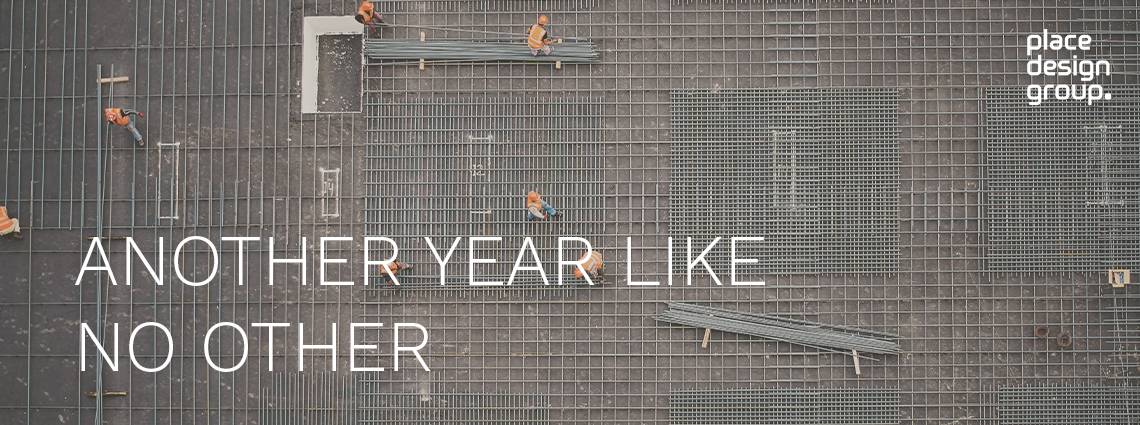2021 was another year like no other, with unexpected ups and downs, twists and turns in every industry, it was the property and infrastructure sector that saw unprecedented growth. While very exciting, this has carried with it new challenges and opportunities.
We sat down with some of our industry experts to reflect on the year that was, their learning and where they think 2022 may take us.

Kirsty Chesser-Brown
CEO at UDIA QLD

Mal Aikman
Director at Innovociti

Amanda Taylor
Principal Planning at Place Design Group

Daniel Nay
Senior Development Manager, Communities at Lendlease
Q1.
Looking back at 2021, what were the big surprises for you in our industry or at an organisational level?
There’s no doubt that 2021 has been an incredibly busy and challenging time for our industry. Despite these challenges, and dire predictions in March 2020, new housing construction was vital to Australia surviving the economic downturn caused by the pandemic. Property has played a prominent role in our economic recovery from COVID, and also to look to what’s really important, collectively working together, adaptability, and flexibility. While the degree of impact and pressure on pricing across the board has been consistent, the specific challenges have differed across our regional branch network. Now, it’s time to begin the hard work needed to fix Australia’s housing affordability crisis, which is fundamentally a function of long-standing imbalances between supply and demand.
– Kirsty Chessher-Brown
Early in the year the boom in house prices took us by surprise. If anything, we had expected prices to fall, with falling population growth from the loss of overseas migration and general economic uncertainty. However other factors came into play and residential prices took off. Chief amongst these were the impact of government stimuli, the inability to spend money on travel, and the reduced supply of dwellings on the market. The Reserve Bank’s decision to communicate that they would keep interest rates down till 2024 also prompted people to borrow to their limit.
– Mal Aikman
I think many started 2021 with a tentative optimism, and on the whole it went better than expected. When you look more closely at certain sectors or geographies there were definitely some clear winners, but its still a little early to know whether the notion of ‘winning’ is real, particularly over the long term. The federal housing grants proved hugely popular, and as a result the housing sector is under significant pressure. The capacity for the industry to deliver on what it promised, housing prices to hold, and homeowners to sustain their substantial financial investments is a very fine balance that needs to be sustained over the next few years.
– Amanda Taylor
The biggest surprise for our team this year is how incredibly resilient the residential market has been. We have seen sustained price increases since the uptick in mid-2020. We had one of the most successful project launches in recent times and even the second round of COVID lockdowns and restrictions did not dampen customers appetite to secure a spot in Sydney’s newest community. The number of transactions undertaken sight-unseen shows how strong the local market is and how the world has evolved to be able to operate remotely when and where required.
– Daniel Nay
Q2.
As we continue to see construction costs rising and materials for supply chains restricted, what impacts do you forsee in the short and long term for the sector?
We are expecting supply and skills challenges to persist across the next 12 months. A strong pipeline of infrastructure investment will continue to also place pressure on skills and construction costs, which will continue to impact the availability of trades and materials for residential construction. The pipeline of major government projects is expected to grow in the lead up to the 2032 Olympics. With the opening of interstate and international borders, we expect Queensland to continue to be the preferred place people call home.
Kirsty Chessher-Brown
Unfortunately, we are already seeing builders struggling financially as a result of the rapid rise in construction costs. We are likely to see this continue into the first half of 2022. Longer term this will sort itself out and what tends to happen is that prices then stabilise for a while which allows the industry to return to a level of stability.
Mal Aikman
There will always be fluctuations, and my reading of the tea leaves is that the current crunch points will ease up a bit, but probably not back to pre-COVID times. In terms of what that means for the industry, I think that it’s a good opportunity to take stock and evaluate if, when and how projects proceed. High costs, supply and labour shortages will absolutely affect how things are delivered and often involve a compromise – it’s important to consider what that means for the end outcome, will the project still yield or deliver what it needs to? If you’re lucky perhaps it will be even!
Amanda Taylor
We see the residential sector remaining strong due to supply constraints and continued demand in the short-medium term. Construction costs are certainly rising, and supply chain restrictions have already become evident with critical infrastructure materials such as concrete pipes blowing out to 20+ week lead-times. This will no doubt favour businesses with strong balance sheets and those with foresight and who are well-prepared. I think it will be most interesting to see how COVID shapes corporate tenancy and working arrangements in the long term.
Daniel Nay
Q3.
With all the highs and lows in 2021, what learnings are you taking into 2022?
Our industry’s ability to adapt to uncertainty has never been more evident but what is also now clear is that the issues impacting housing delivery are widely known across industry and government, with solutions available. We’ve built a strong platform of viable, tried and tested solutions to help our state maintain its affordability advantages. We’re looking forward to continuing to discuss both quick fixes and systemic reform with state and local governments in 2022. The time to act is now, and we are committed to working with government to ensure our industry can continue to deliver the type of housing people want, in the location they want to live, at a price they can afford.
– Kirsty Chessher-Brown
The big learning for me is to not underestimate how much the government can influence the economy and specific sectors when it opens its purse strings. Having said that, I don’t think we can afford for them to spend their way out of another downturn the way they did for this last one. Future generations will be paying this debt off for some time. The other learnings are around how a global force like the COVID-19 pandemic fast tracked trends we had seen evolving. Particularly online retail, working from home, online study, and video meetings.
– Mal Aikman
How important it is to connect and communicate with one another, no matter the frequency or forum. Whether teammates, clients, or colleagues – in 2020/21 we quickly adopted new technology and styles of communication into our lives. As we go into 2022, I think it will be about refining this new hybrid style of communication and connection. We need to make the most of the efficiencies that an online forum affords us, but not overly rely on it, there will always be a time that catching up for a coffee, or in person meetings and collaboration will be best.
– Amanda Taylor
Be adaptive and prepared to respond to changes as they arise. Most of all, enjoy the time with our families, friends, and colleagues when we can be together.
– Daniel Nay
